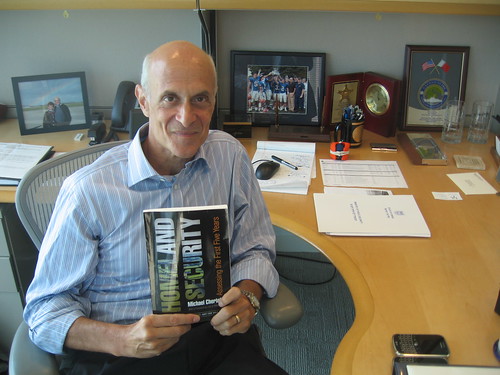In an interview just before the release of his new book, former U.S. Homeland Security Secretary Michael Chertoff urges that the terror color codes should be condensed to three levels, calls for the development of a new preparedness course (including first aid, CPR, basic mechanics, and firearms training) for schools across the U.S., acknowledges “he would have liked to have done more” on citizen readiness during his tenure, and says that his successor Janet Napolitano is doing “a very good job”.
Chertoff’s book, Homeland Security: Assessing the First Five Years (University of Pennsylvania Press) will go on sale Tuesday. In a post earlier in the summer, I wrote about the book’s contents which focus a good deal on the role of the public in homeland security: “In New Book, Former DHS Secretary Chertoff Warns About “Complacency,” Returning To A “September 10″ Mindset”; Urges Government To Have “Frank Discussion” & “Be Candid With American People, Sharing As Much Information As Possible About Dangers We Face”.
We spoke a couple weeks ago at the Washington, D.C. office of the Chertoff Group, a security and risk management advisory firm, he opened earlier this year. (Not surprisingly, the former Secretary looks more tanned and rested than when I last interviewed him almost exactly a year ago at DHS headquarters before he left for the Gulf Coast to supervise Hurricane Gustav preparations.)
As excerpts from a new book from Chertoff’s predecessor Tom Ridge had been released just a few minutes before our interview indicating that politics may have been a part of terror color alerts decisionmaking, I first asked Chertoff whether he had ever felt any political pressure. He said he “never” had.
Yet, Chertoff does believe there need to be some changes made to the current alert system, most notably that the colors should be condensed from five to three levels —  because he says “we’re not going to get below yellow.†He recommended in testimony to the new DHS alert task force that there be “a steady state, a heightened alert and then Red”. Though he believes Red may have to be delineated with a little more specificity (ie. if an incident has happened, but there is no intelligence about another attack vs. when the government believes another strike is imminent).
As far as citizen preparedness, Chertoff says that a key to creating a long-term prepared nation is to focus on schools and kids. In the interview, he sketched out two suggestions  – a “minimum” and a “maximum” approach. The “minimum” would be “to get the fire management and emergency management people to come together to create a program to be exported to the schools on basic preparation.”
Chertoff’s “maximum” option is that there be a more substantive course developed for U.S. schools on planning and preparation which would include teaching “basic skills,” such as first aid, CPR, swimming, driving, basic mechanics and operating a firearm.
“If you’re not going to have a national service then as part of graduation from high school there should be a course over a period of time that teaches you the kind of basic things you might need in an emergency,” Chertoff says, adding “It’s going to do two things. It’s going to create a cadre of more capable people, but it is also going to demystify the process of preparation. Most people are intimidated that they don’t know how to do it. They’re afraid of being embarrassed.”

MICHAEL CHERTOFF IN HIS OFFICE WITH HIS NEW BOOK, HOMELAND SECURITY: ASSESSING THE FIRST FIVE YEARS
Chertoff, who during his tenure at DHS would often urge Americans to be “vigilant” about terrorism, says Americans need to be aware but not paranoid. As a model, he suggests the ways most people deal with crime: “We all teach our kids not to be afraid to go outside but not to walk down a dark alley at 3am.”
In his new book, Chertoff suggests the government share more information with the public about the threats facing the nation. But he says it is not necessarily a matter of declassifying more things but of doing a better job of “packaging and presenting” the facts at a time when there are so many other issues competing for the public’s attention. His concern — eight years after 9/11 — is that citizens become complacent, and he urges the public to continue to support government investments in preventing and responding threats, particularly in the biological and nuclear area.
Chertoff says he “would have liked to have done more” on citizen preparedness during his tenure. He believes some things were accomplished with the Ready.Gov program, but that it was difficult to communicate with the public on these issues:Â ”It was hard under our Administration because it got freighted with a lot of political stuff. There were people who viewed counter terrorism, homeland security as a Bush thing and therefore anything you did in that area those people automatically objected to because they were opposed to Bush. In the new Administration, there will be a little less resistance. Sometimes the person who starts something isn’t the person to finish it.”
Chertoff believes his successor Janet Napolitano is “doing a very good job”. He is particularly happy that she has continued the “non-political” and “non-partisan” approach to homeland security which is how he says he tried to run the Department and believes the nation is best served.
As I wrote in my initial writeup, I would recommend the new book to anyone interested in homeland security (and for that matter public policy). Chertoff’s perspective is unique — not only was he of one of three Homeland Security Secretaries in the nation’s history, but he also headed U.S. Justice Department’s Criminal Division post-9/11 and served as a federal judge. It can be purchased here.



